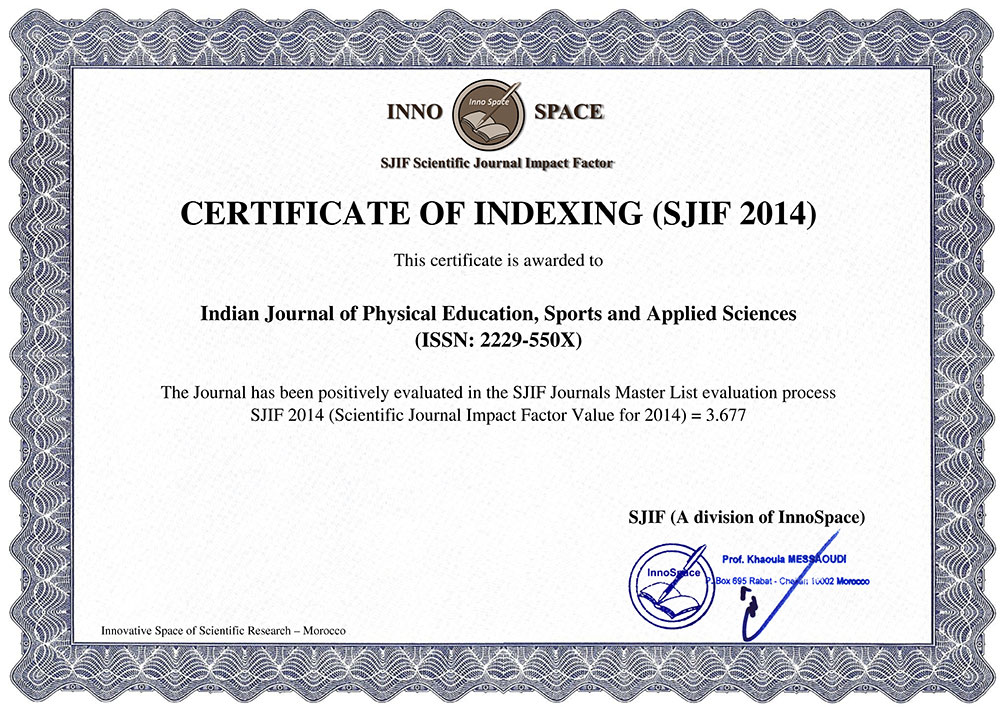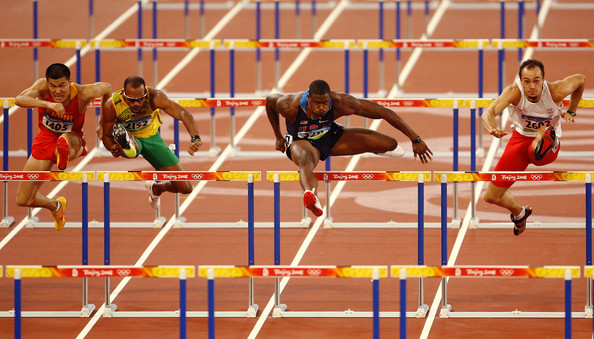PHYSIOLOGICAL RESPONSES OF ZUMBA: AN OVERVIEW UNDERSTANDING THE POPULAR FITNESS TREND
Volume 7-Number 4, October, 2017 November 5, 2017| Author name : | Manjula Suri, Rekha Sharma, Namita Saini | ||||
|---|---|---|---|---|---|
| Page no : | 23-31 | Volume : | 7 | Issue : | 4 |
doi no.: 05-2016-44975451, DOI Link :: http://doi-ds.org/doilink/11.2017-69346454/
Manjula Suri 1, Rekha Sharma 2, Namita Saini 3
Affiliations
1 Department of Physiology and Promotive Health, University of Delhi, Institute of Home Economics, mnjlsuri@gmail.com
2 Department of Physical Education, University of Delhi, Institute of Home Economics, drrekhasharma1984@gmail.com
3 Department of Physical Education, University of Delhi, Institute of Home Economics, Hauz Khas, Delhi- 110016, drnamitasaini@rediffmail.com
ABSTRACT
Physical inactivity is a commonly observed cause of increasing incidence of lifestyle diseases. As dancing is a physical activity that can be tailored to fit a target population’s age and culture therefore, zumba is becoming a global dance fitness activity to reduce lifestyle disease epidemic . It has a mixture of popular entertaining music, different dance styles and aerobic exercises which improves the health of all age groups. Thus, physiological effects of zumba can be used as an adjuncts to conventional medicine for prevention of various lifestyle diseases e.g. diabetics and obesity. Several neurological benefits of zumba have been identified which ranges from memory improvement to strengthened neuronal connections. Zumba is able to enhance cardio vascular endurance and cardio respiratory functions. It incorporates movement of large muscle groups for aerobic endurance, strength training and flexibility thereby contributing to improved health in all ages, especially in the geriatric population. It also maintains bone density and prevents osteoporosis in postmenopausal women. Various researchers have recorded the positive effect of Zumba on weight, BMI, body fat mass, hormonal profile and reproductive function. Psychosocial aspect of health also shows encouraging results in Zumba intervention. To summarize, these findings reflect that Zumba intervention can be explored further as a therapeutic tool in Complementary and alternative medicine for improving health and preventing lifestyle diseases.
Keywords: Zumba, Musculoskeletal, Psychosocial, Geriatric, cardio vascular endurance.
DOWNLOAD FULL TEXT: 
BIBLIOGRAPHY
Anja Rossmeissl et.al. (2016). Zum Beat: Evaluation of a Zumba Dance Intervention in Postmenopausal Overweight Women, Sports” 4, 5; doi:10.3390/sports4010005
Araneta, M.R.; Tanori, D. (2015). “Benefits of zumba fitness among sedentary adults with components of the metabolic syndrome: A pilot study”. J. Sports Med. Phys. Fit. 55, 1227–1233.
Berard A, Bravo G, Gauthier P. (1997). Meta-analysis of the effectiveness of physical activity for the prevention of bone loss in postmenopausal women. Osteoporosis International, 7(4):331-337.
Barene, S.; Krustrup, P.; Brekke, O.L.; Holtermann, A. (2014). Soccer and Zumba as health-promoting activitiesamong female hospital employees: A 40-weeks cluster randomised intervention study. J. Sports Sci., 32,1539–1549.
Barene, S.; Krustrup, P (2014). Holtermann, A. Effects of the workplace health promotion activities soccer andZumba on muscle pain, work ability and perceived physical exertion among female hospital employees. PLoS ONE, 9, e115059.
Barene, S.; Krustrup, P.; Jackman, S.R.; Brekke, O.L.; Holtermann, A.(2014). Do soccer and Zumba exercise improve fitness and indicators of health among female hospital employees? A 12-week rct. Scand. J. Med. Sci. Sports, 24, 990–999.
Beitins IZ., Decreased Hypothalamic Gonadotropin-Releasing Hormone Secretion in Male Marathon Runners. N Engl J Med 1986; 315: 411.
Belardinelli, R. (2007). Exercise training in chronic heart failure: How to harmonize oxidative stress, sympathetic outflow, and angiotensin II. Circulation, 115, 3042–3044.
Bennett, P.; Corradini, A.; Ockerby, C.; Cossich, T. (2012). Exercise during hemodialysis the intradialytic Zumba Gold.Nephrol. News Issues 2012, 26, 31–32.
Blasing B. et al. (2012). Neurocognitive control in dance perception and performance. Acta. psychologica139, 300–308.
Borer KT, Fogleman K, Gross M, La New JM, Dengel D.(2007). Walking intensity for postmenopausal bone mineral preservation and accrual. Bone, 41(4):713-721.
Borer KT. (1994). Neurohumoral mediation of exercise-induced growth. Med Sci Sports Exerc. 26(6):741-754.
Borer KT. (2005). Physical activity in the prevention and amelioration of osteoporosis in women : interaction of mechanical, hormonal and dietary factors. Sports Med. 35(9):779-830.
Brooks-Gunn J, Warren MP (1985). Effects of Delayed Menarche in Different Contexts: Dance and Nondance Students. J Youth Adolesc. 14:285.
Brown S., Martinez M. J. & Parsons L. M. (2006). The neural basis of human dance. Cereb. Cortex 16, 1157–1167,
Calvo-Merino B., Jola C., Glaser D. E. & Haggard P. (2008). Towards a sensorimotor aesthetics of performing art. Consciousness and cognition 17, 911–922.
Coubard, O.A.; Duretz, S.; Lefebvre, V.; Lapalus, P.; Ferrufino, L.(2011). Practice of contemporary dance improves cognitive flexibility in aging. Front. Aging Neurosci. 3.
Cross E. S., Kirsch L., Ticini L. F. & Schutz-Bosbach S. (2011). The impact of aesthetic evaluation and physical ability on dance perception. Frontiers in human neuroscience 5, 102.
Cruz-Garza J. G., Hernandez Z. R., Nepaul S., Bradley K. K. & Contreras-Vidal J. L. (2014). Neural decoding of expressive human movement from scalp electroencephalography (EEG). Frontiers in human neuroscience 8, 188, 10.3389/fnhum.2014.00188.
Delextrat AA, Warner S, Graham S, Neupert E. (2016). An 8-Week Exercise Intervention Based on Zumba Improves Aerobic Fitness and Psychological Well-Being in Healthy Women J Phys Act Health. 13 (2):131-9. doi: 10.1123/jpah.2014-0535. Epub 2015 Jun 15.
Dimondstein, G. (1985). Journal of Aesthetic Education. 19 (4), 77-84
Donath, L.; Roth, R.; Hohn, Y.; Zahner, L.; Faude, O. (2014). The effects of zumba training on cardiovascular and neuromuscular function in female college students. Eur. J. Sport Sci. 14, 569–577.
Duberg, A.; Hagberg, L.; Sunvisson, H.; Moller, M. (2013). Influencing self-rated health among adolescent girls with dance intervention: A randomized controlled trial. JAMA Pediatr. 167, 27–31.
Ehrman, J.K., Gordon, P.M., Visich, P.S., Keteyian, S.J. (2009). Clinical Exercise Physiology , (2nd ed.). Champaign, IL: Human Kinetics.
Eschbach, Chris (2016). Exercise recommendations for menopause-aged women. ACSM: Public Information. Retrieved from:http://www.acsm.org/public-information/articles/2016/10/07/exercise-recommendationsfor-menopause-aged-women
Fairhall S. L. & Ishai A. (2008). Neural correlates of object indeterminacy in art compositions. Consciousness and cognition 17, 923–932.
Faulkner, S.H., Pugh, J.K., Hood, T.M., Menon, K., King, J.A., & Nimmo, M.A. (2015). Group studio cycling; an effective intervention to improve cardio-metabolic health in overweight physically inactive adults. Journal of Fitness Research, 4(2), 16-25.
Fitness Guinea Pig: Zumba, Brides Magazine
Gillett, P.A.; Eisenman, P.A. (1987). The effect of intensity controlled aerobic dance exercise on aerobic capacity of middle-aged, overweight women. Res. Nurs. Health 10, 383–390.
Grosbras M.-H., Tan H. & Pollick F.(2012). Dance and emotion in posterior parietal cortex: A low-frequency rTMS study. Brain stimulation 5, 130–136.
Gullu, E.; Gullu, A.; Cicek, G.; Yamaner, F.; Imamoglu, O.; Gumusdag, H. (2013). The effects of aerobic exercises on cardiovascular risk factors of sedentary women. Int. J. Acad. Res. 5, 160–167.
Hanggi J., Koeneke S., Bezzola L. and Jancke L. (2010). Structural neuroplasticity in the sensorimotor network of professional female ballet dancers. Human brain mapping 31, 1196–1206.
Hüfner K., Binetti C., Hamilton D. A., Stephan T., Flanagin V. L., Linn J., et al. (2011). Structural and functional plasticity of the hippocampal formation in professional dancers and slackliners.Hippocampus 21 855–865. 10.1002/hipo.20801
Inouye, J.; Nichols, A.; Maskarinec, G.; Tseng, C.W. (2013). A survey of musculoskeletal injuries associated with zumba.Hawaii J. Med. Public Health, 72, 433–436.
Kattenstroth JC, Kalisch T, Kolankowska I, Dinse HR.(2011). Balance, sensorimotor, and cognitive performance in long-year expert senior ballroom dancers. J Aging Res.
Kattenstroth, J.C.; Kalisch, T.; Holt, S.; Tegenthoff, M.; Dinse, H.R.(2013). Six months of dance intervention enhances postural, sensorimotor, and cognitive performance in elderly without affecting cardio-respiratory functions. Front. Aging Neurosci, 5.
Kim, S.H.; Kim, M.; Ahn, Y.B.; Lim, H.K.; Kang, S.G.; Cho, J.H.; Park, S.J.; Song, S.W. (2011). Effect of dance exercise on cognitive function in elderly patients with metabolic syndrome: A pilot study. J. Sports Sci. Med. 10, 671–678.
Kjell Hausken, Sindre M. Dyrstad (2013). Heart Rate, Accelerometer Measurements, Experience and Rating of Perceived Exertion in Zumba, Interval Running, Spinning, and Pyramid Running, Journal of Exercise Physiology online, 16 (6) : 39 .
Krishnan, S.; Tokar, T.N.; Boylan, M.M.; Griffin, K.; Feng, D.; McMurry, L.; Esperat, C.; Cooper, J.A. (2015). Zumba® dance improves health in overweight/obese or type 2 diabetic women. Am. J. Health Behav. 39, 109–120.
Ljubojevic, A., Jovanovic, S., Zrnic, R., & Sebic, L. (2016). Zumba fitness cardio exercise: the effects on body fat mass reduction of woman. Homo Sporticus, 1. 32-35.
Lloyd, J. (2011). Zumba brings the dance party into the health club. USA TODAY. http://usatoday30.usatoday.com/news/health/wellness/fitness-food/exercise/story/2011-10-27/Zumba-brings-the-dance-party-into-the-health-club/50940786/1
Luettgen, M, Foster, C, Doberstein, S, Mikat, R, & Porcari, J (2012) Zumba (R): Is the “fitness-party” a good workout? Journal of Sports Science & Medicine, 11, 357-358.
Luger A, Deuster P, Kyle SB, et al.(1987). Acute Hypothalamic-Pituitary-Adrenal Responses to the Stress of Treadmill Exercise: Physiologic Adaptations to Physical Training. N Engl J Med. 316:1309.
Metabolic and endocrine response to exercise: sympathoadrenal …joe.endocrinologyjournals.org/content/224/2/R79. D Ball – 2015 )
Michael J. Hove, Kazuki Suzuki, Hirotaka Uchitomi, Satoshi Orimo, and Yoshihiro Miyake, (2012) Interactive Rhythmic Auditory Stimulation Reinstates Natural 1/f Timing in Gait of Parkinson’s Patients. PLoS One, 7(3): e32600. Published online 2012 Mar 2. doi: 10.1371/journal.pone.0032600
Mosher, P.E.; Ferguson, M.A.; Arnold, R.O.(2005). Lipid and lipoprotein changes in premenstrual women following step aerobic dance training. Int. J. Sports Med. 26, 669–674.
Murrock, C.J.; Gary, F.A. (2010). Culturally specific dance to reduce obesity in african american women. Health Promot. Pract. 11, 465–473.
Murrock, C.J.; Graor, C.H. (2014) The effects of dance on depression, physical function, and disability in underserved adults. J Aging Phys Act, 22, 380–385.
Nieri, T., & Hughes, E. (2016). All about having fun: women’s experience of Zumba fitness.Sociology of Sport Journal, 33. 133-135.
Ogden, C.L., Carrol, M.D., Fryar, C.D., & Flegal, K.M. (2015). Prevalence of obesityamong young adults and youth: United States, 2011-2014. NHCS Data Brief: no 219.Hyattsville, MD: National Center for Health Statistics.
Okura, T.; Nakata, Y.; Ohkawara, K.; Numao, S.; Katayama, Y.; Matsuo, T.; Tanaka, K. (2007). Effects of aerobic exercise on metabolic syndrome improvement in response to weight reduction. Obesity . 15, 2478–2484.
Otto, R.M.; Maniguet, E.; Peters, A.; Boutagy, N.; Gabbard, A.;Wygand, J.W.; Yoke, M.(2016). The Energy Cost of Zumba Exercise. Med. Sci. Sports Exerc. 2011, 43. [CrossRef] Sports, 4, 5 14 of 15
Paffenbarger RS, Blair SN, Lee IM. (2001). A history of physical activity, cardiovascular health and longevity: the scientific contributions of Jeremy N Morris, DSc, DPH, FRCP. International Journal of Epidemiology; 30(5):1184-1192.
Parcher A. (2008). Zumba shakes the monotony of ordinary aerobic classes. The Washington Post. http://articles.washingtonpost.com/2008-07-31/news/36857857_1_alberto-perlman-alberto-aghion-zumbafitness.)
Pescatello, L.S., Arena, R., Riebe, D., & Thompson, P.D. (2013). ACSM’s guidelines for exercise testing and prescription. (9th ed.). Baltimore, MD: Wolters Kluwer: Lipincott,Williams, & Wilkins.
Pescatello, L.S., Arena, R., Riebe, D., & Thompson, P.D. (2013). ACSM’s guidelines for exercise testing and prescription. (9th ed.). Baltimore, MD: Wolters Kluwer: Lipincott, Williams, & Wilkins.
Peterson, M.J.; Pieper, C.F.; Morey, M.C. (2003). Accuracy of VO2(max) prediction equations in older adults. Med. Sci.Sports Exerc. 35, 145–149.
Jitesh et al, (2016). Effect Of Zumba Dance On Blood Pressure, J. Pharm. Sci. & Res. Vol. 8(6), 501-505, 0975-1459
Sanders, M E, & Prouty, J, (2012). Zumba (R) Fitness is Gold for All Ages. ACSM’s Health & Fitness Journal, 16, 25-28.
Sawada M., Suda K. & Ishii M.(2003). Expression of emotions in dance: relation between arm movement characteristics and emotion. Percept. Mot. Skills 97, 697–708, 10.2466/pms.2003.97.3.697 .
Schrimpf, C.; Haastert-Talini, K.; von Falck, C.; Rustum, S.; Wilhelmi, M.; Teebken, O.E.(2014). High sport sneakersmay lead to peripheral artery occlusion in Zumba® dancers. Vasa, 43, 78–80.
Schuenke M, Mikat R, McBride J. (2002). Effect of an acute period of resistance exercise on excess post-exercise oxygen consumption: implications for body mass management. European Journal of Applied Physiology; 86(5):411-417.
Shimamoto, H.; Adachi, Y.; Takahashi, M.; Tanaka, K.(1998). Low impact aerobic dance as a useful exercise mode for reducing body mass in mildly obese middle-aged women. Appl. Hum. Sci. 17, 109–114.
Snowling, N. J., & Hopkins, W. G., (2006). Effects of Different Modes of Exercise Training on Glucose Control and Risk Factors for Complications in Type 2 Diabetic Patients A meta-analysis. Diabetes Care, 29(11), 518–2527. http://doi.org/10.2337/dc06-1317
Somayeh Abdolahian, Fatemeh Ghavi, Sareh Abdollahifard, and Fatemeh Sheikhan ((2014). Effect of Dance Labor on the Management of Active Phase Labor Pain & Clients’ Satisfaction: A Randomized Controlled Trial Study. Glob. J. Health Sci. 6(3): 219–226.
Stevens C. et al. (2010). Perceiving dance: schematic expectations guide experts’ scanning of a contemporary dance film. Journal of dance medicine & science: official publication of the International Association for Dance Medicine & Science 14, 19–25.
Thomson, W.R. (2012). Worldwide survey of fitness trends for 2013. ACSMs Health Fit. J. 16, 8–17.
Warburton DER, Nicol CW, Bredin SSD. (2006). Health benefits of physical activity: the evidence. Canadian Medical Association Journal , 174(6):801-809.
Welsh L, Rutherford O.(1996). Hip bone mineral density is improved by high-impact aerobic exercise in postmenopausal women and men over 50 years. European Journal of Applied Physiology and Occupational Physiology , 74(6):511-517.
Williford, H.N.; Blessing, D.L.; Barksdale, J.M.; Smith, F.H. (1988). The effects of aerobic dance training on serum lipids, lipoproteins and cardiopulmonary function. J. Sports Med. Phys. Fit. 28, 151–157.
Wikipedia:Zumba
Wootton, David M., and David N. Ku. (1999). “Fluid Mechanics of Vascular Systems, Diseases, and Thrombosis.” Annual Review ofBiomedical Engineering Annu. Rev. Biomed. Eng. 1.1: 299-329
Yarrow K., Brown P. & Krakauer J. W. (2009). Inside the brain of an elite athlete: the neural processes that support high achievement in sports. Nat. Rev. Neurosci. 10, 585–596.







